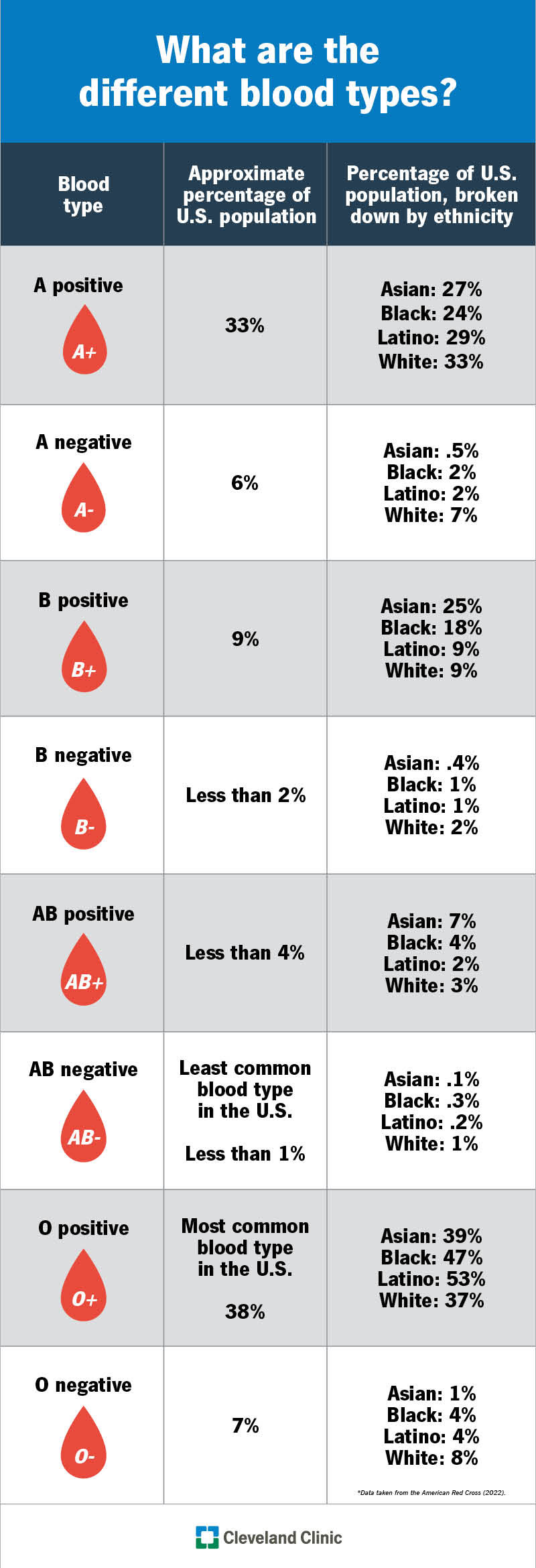Blood type is a critical component of a person’s health profile, influencing compatibility in transfusions and organ transplants. There are four main blood types, each with unique characteristics that set them apart from one another. The ABO blood group system, developed by Karl Landsteiner, categorizes blood into A, B, AB, and O.

These types are further classified into Rh positive and negative, resulting in eight distinct blood types. Understanding the differences between these blood types is crucial for medical professionals to ensure safe blood transfusions and transplants. This article delves into the specifics of each blood type, exploring their unique traits and implications for health.
Understanding the Different Blood Types
Blood is classified into several types based on the presence or absence of specific antigens on the surface of red blood cells. These types are crucial for transfusions and organ transplants, as compatibility is vital to avoid adverse reactions. The main classification system used worldwide is the ABO blood group system, which includes four primary types: A, B, AB, and O. Additionally, there is another antigen called the Rh factor, which further divides each type into Rh-positive (Rh+) and Rh-negative (Rh-).
What is the ABO Blood Group System?
The ABO blood group system categorizes blood into four main types: A, B, AB, and O. This classification is based on the presence or absence of two antigens, A and B, on the surface of red blood cells. People with type A blood have the A antigen, those with type B blood have the B antigen, individuals with type AB blood have both A and B antigens, and those with type O blood have neither A nor B antigens.
What is the Rh Factor?
The Rh factor is another antigen present on the surface of most people’s red blood cells. If you have this antigen, you are considered Rh-positive (Rh+), and if you don’t, you are considered Rh-negative (Rh-). The combination of the ABO blood group and the Rh factor results in eight possible blood types: A+, A-, B+, B-, AB+, AB-, O+, and O-.
What are the Rare Blood Types?
Besides the common ABO blood types, there are several rare blood types. One such example is the Bombay phenotype, also known as hh or para-Bombay phenotype. This type lacks the H antigen, which is present in almost all humans. Another rare type is the Rh-null phenotype, where an individual lacks all Rh antigens.
How is Blood Type Determined?
Blood type is determined by genetics. Each parent contributes one of two alleles (A or O) for the ABO gene, resulting in the possible genotypes AA, AO, or OO. The genotype AA or AO results in type A blood, while the genotype OO results in type O blood. Type B blood is determined by a different gene, and the combination of these genes determines the overall blood type.
Why is Knowing Your Blood Type Important?
Knowing your blood type is essential for several reasons. It helps in ensuring compatibility during blood transfusions and organ transplants, reducing the risk of adverse reactions. Additionally, it can provide insights into potential genetic traits and help in understanding the risk of certain diseases.
| Blood Type | Description |
|---|---|
| A+ | Has A and Rh antigens |
| A- | Has A antigen but lacks Rh antigen |
| B+ | Has B and Rh antigens |
| B- | Has B antigen but lacks Rh antigen |
| AB+ | Has A, B, and Rh antigens |
| AB- | Has A and B antigens but lacks Rh antigen |
| O+ | Lacks A and B antigens but has Rh antigen |
| O- | Lacks A, B, and Rh antigens |
What is the rarest type of blood?
The rarest type of blood is Rh-null, also known as Bombay blood. This type was first discovered in 1952 in a Mumbai hospital and has since been found in less than 50 people worldwide. It lacks all of the antigens present on red blood cells, making it incompatible with every other blood type. This blood type is extremely rare and can only be donated to individuals with the same blood type.
- Antigens: Rh-null blood lacks all antigens present on red blood cells.
- Compatibility: It is incompatible with every other blood type.
- Donation: Can only be donated to individuals with the same blood type.
Other rare blood types
While Rh-null is the rarest, there are other blood types that are considered rare as well. These include:
- Ah: This type lacks the H antigen, which is present in most people’s blood. It is found in about 1 in 1,000 people.
- Lund: This type has an unusual antigen that can trigger an immune response in people without it. It is found in about 1 in 2,000 people.
- Vel: This type lacks the Vel antigen, which is present in about 99.8% of the population. It is found in about 1 in 2,500 people.
Importance of rare blood types
Rare blood types, including Rh-null, play a crucial role in medical research and treatment. They can help scientists understand how different blood types interact and respond to various diseases and treatments. Additionally, having access to these rare blood types can save lives in emergency situations where a specific type is needed for transfusion.
- Medical research: Rare blood types help scientists understand how different blood types interact and respond to various diseases and treatments.
- Emergency situations: Access to rare blood types can save lives in emergency situations where a specific type is needed for transfusion.
- Transfusion medicine: Rare blood types are essential for the study and practice of transfusion medicine, helping to ensure compatibility and safety in blood transfusions.
What is the healthiest blood type?
What is the Healthiest Blood Type?
There is no definitive answer to what the healthiest blood type is, as each blood type has its own set of advantages and disadvantages. However, studies have shown that certain blood types may have an edge when it comes to specific health issues.
Advantages of Blood Type O
Blood type O is often considered the healthiest blood type due to its lower risk of developing certain diseases. Some of the advantages include:
- Lower risk of heart disease: Studies have shown that individuals with blood type O have a lower risk of developing heart disease compared to other blood types.
- Lower risk of diabetes: Blood type O individuals have been found to have a lower risk of developing type 2 diabetes.
- Lower risk of stomach ulcers: Blood type O individuals are less likely to develop stomach ulcers due to the bacterium Helicobacter pylori, which is more common in individuals with other blood types.
Disadvantages of Blood Type O
While blood type O may have several health advantages, it also comes with some disadvantages:
- Increased risk of bleeding: Blood type O individuals tend to have lower levels of von Willebrand factor, a protein that helps blood clot, which can lead to increased bleeding.
- Increased risk of stomach cancer: Despite having a lower risk of stomach ulcers, blood type O individuals have been found to have an increased risk of stomach cancer.
- Increased risk of rheumatoid arthritis: Studies have shown that blood type O individuals are more likely to develop rheumatoid arthritis.
Other Blood Types and Their Health Implications
While blood type O may have its advantages and disadvantages, other blood types also have their own set of health implications:
- Blood Type A: Individuals with blood type A have been found to have a higher risk of developing stomach cancer and diabetes, but they also have a lower risk of heart disease.
- Blood Type B: Blood type B individuals have been found to have a lower risk of heart disease and diabetes, but they have a higher risk of developing stomach ulcers and rheumatoid arthritis.
- Blood Type AB: Blood type AB individuals have been found to have a higher risk of heart disease and diabetes, but they have a lower risk of stomach ulcers and rheumatoid arthritis.
What are the 7 blood types?
There are actually only four main blood types, not seven. These are classified as A, B, AB, and O. However, there are variations of these main types, which can sometimes be referred to as additional blood types. The four main blood types are classified based on the presence or absence of certain antigens on the surface of red blood cells. The main blood types are further divided into positive or negative based on the presence of the Rh antigen. This gives us a total of eight common blood types: A+, A-, B+, B-, AB+, AB-, O+, and O-. Each blood type has different antibodies and antigens, making compatibility crucial for blood transfusions.
What are the main blood types?
The four main blood types are A, B, AB, and O. These types are determined by the presence or absence of specific antigens on the surface of red blood cells. The main blood types are further divided into positive or negative based on the presence of the Rh antigen.
- A: This blood type has A antigens on the surface of the red blood cells.
- B: This blood type has B antigens on the surface of the red blood cells.
- AB: This blood type has both A and B antigens on the surface of the red blood cells.
- O: This blood type has neither A nor B antigens on the surface of the red blood cells.
What are the variations of the main blood types?
The main blood types are further divided into positive or negative based on the presence of the Rh antigen. This gives us a total of eight common blood types: A+, A-, B+, B-, AB+, AB-, O+, and O-. Each blood type has different antibodies and antigens, making compatibility crucial for blood transfusions.
- A+: This blood type has A antigens and the Rh antigen.
- A-: This blood type has A antigens but does not have the Rh antigen.
- B+: This blood type has B antigens and the Rh antigen.
- B-: This blood type has B antigens but does not have the Rh antigen.
- AB+: This blood type has both A and B antigens and the Rh antigen.
- AB-: This blood type has both A and B antigens but does not have the Rh antigen.
- O+: This blood type has neither A nor B antigens and has the Rh antigen.
- O-: This blood type has neither A nor B antigens and does not have the Rh antigen.
Why is blood type compatibility important?
Blood type compatibility is crucial for blood transfusions. If a patient receives blood that is not compatible with their own blood type, their immune system may react to the new blood cells and cause a severe reaction. For this reason, it is essential to match the blood type of the donor with that of the recipient. Blood type compatibility is also important for pregnant women, as an incompatibility between the mother’s and fetus’ blood types can cause complications during pregnancy.
- Transfusions: Blood type compatibility is crucial for blood transfusions to avoid severe reactions.
- Pregnancy: Blood type compatibility is important for pregnant women to avoid complications during pregnancy.
What is the universal blood type?
What is the Universal Blood Type?
Understanding Blood Types
The universal blood type, also known as the universal donor, is O negative (O-). This blood type is compatible with all other blood types, making it the safest choice for transfusions when there is no time to determine the recipient’s blood type. However, it’s important to note that while O- blood can be given to anyone, it’s also the rarest blood type, making it highly sought after for transfusions.
There are four main blood types: A, B, AB, and O. Each type is further classified as either positive or negative based on the presence of the Rh antigen. The Rh factor is a protein found on the surface of red blood cells in most people. Those who have the Rh factor are considered Rh positive, while those who do not have it are considered Rh negative.
When it comes to blood transfusions, the goal is to match the blood type of the donor with that of the recipient as closely as possible to prevent an adverse reaction. This is why O- blood is so valuable, as it can be safely given to anyone regardless of their blood type.
- There are four main blood types: A, B, AB, and O.
- Each blood type is further classified as either positive or negative based on the presence of the Rh antigen.
- O negative (O-) blood is the universal blood type, making it compatible with all other blood types.
Why is O Negative Blood Universal?
O negative blood is considered the universal blood type because it lacks A and B antibodies on the surface of the red blood cells, as well as the Rh antigen. This means that it won’t trigger an immune response in recipients with A, B, AB, or O blood types, regardless of their Rh status.
When a patient receives blood that contains antibodies their immune system doesn’t recognize, their body will attack the foreign cells, leading to a potentially life-threatening reaction. Since O- blood doesn’t contain any A or B antibodies, it’s safe for use in emergency situations where there isn’t time to determine the recipient’s blood type.
- O negative blood lacks A and B antibodies on the surface of the red blood cells.
- O negative blood also lacks the Rh antigen.
- This makes O negative blood compatible with all other blood types.
Importance of O Negative Blood
O negative blood is highly sought after for several reasons:
Firstly, it’s the safest choice for newborn babies who require blood transfusions. Since newborns haven’t developed antibodies against A and B antigens yet, O- blood ensures there’s no risk of an adverse reaction.
Secondly, O- blood is crucial in emergency situations where there isn’t time to determine the recipient’s blood type. In these situations, O- blood can be safely administered to anyone, regardless of their blood type.
Lastly, O- blood is essential for patients who require ongoing transfusions, such as those with sickle cell disease or thalassemia. These patients often develop antibodies against other blood types over time, making O- blood the only compatible option.
- O negative blood is the safest choice for newborn babies who require blood transfusions.
- O negative blood is crucial in emergency situations where there isn’t time to determine the recipient’s blood type.
- O negative blood is essential for patients who require ongoing transfusions.
Frequently Asked Questions
What are the different blood types?
Blood types are classified based on the presence or absence of specific antigens on the surface of red blood cells. There are four main blood types, which are determined by the presence or absence of two antigens called A and B. These blood types are A, B, AB, and O. Type A has the A antigen, Type B has the B antigen, Type AB has both A and B antigens, and Type O has neither A nor B antigens.
How do blood types affect blood transfusions?
Blood type compatibility is crucial for blood transfusions. If a person receives blood that contains an antigen their immune system doesn’t recognize, it can trigger an immune response, which can be dangerous. For example, if a person with Type A blood receives Type B blood, their immune system will react to the B antigen and cause complications. Therefore, it’s essential to match the blood type of the donor and the recipient during a transfusion.
What is the Rh factor in blood types?
Rh factor, also known as the Rhesus factor, is another antigen that can be present or absent on the surface of red blood cells. If an individual has the Rh antigen, they are considered Rh-positive, and if they lack it, they are Rh-negative. This factor is important for pregnant women, as an Rh-negative woman carrying an Rh-positive fetus can develop antibodies against the fetus’s blood, leading to complications in future pregnancies. To prevent this, Rh-negative women are often given an injection of Rho(D) immune globulin during pregnancy.
Can blood types determine a person’s health risks?
While blood type does not directly determine a person’s health risks, there are some associations between certain blood types and increased risk of specific conditions. For instance, people with Type A blood have been found to have a higher risk of coronary heart disease, while those with Type O blood may have a lower risk. However, it’s essential to note that these associations are not definitive and should not be considered as the sole predictor of health risks. Other factors, such as lifestyle, genetics, and environmental factors, play a much more significant role in determining overall health.
I’ve been working in technology and IT since 1993 and on the Internet as a blogger and webmaster since 2004. I love technology, gadgets, movies and travel. I love researching and writing about technology, travel and cars.


